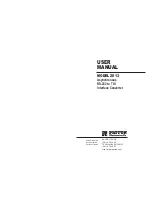
262
This instrument supports mathematical combination and functional transformations of waveforms
it acquires. The following figure shows this concept:
You create math waveforms to support the analysis of your channel and reference waveforms. By
combining and transforming source waveforms and other data into math waveforms, you can
derive the data view that your application requires. Create math waveforms that result from:
Mathematical operations on one or several waveforms: add, subtract, multiply, and divide.
Functional transformations of waveforms, such as integration, differentiation, and so on.
Spectral analysis of waveforms, such as testing impulse response.
You can create up to four math waveforms (two for 2-channel TDS5000B instruments).
Measurement scalars can be used in math expressions. For example, you can measure the average
of a waveform (using the measurement capabilities of the instrument) and subtract it from the
original waveform to define a new math waveform. Measurements 1 through 8 are allowed in a
math definition, but not measurement functions (such as rise (Ch1)).
In FastFrame, math is applied to each frame.
This instrument supports the following operations for math waveforms:
Vertical display scaling and positioning
Taking automatic measurements
Taking cursor measurements
Using histograms
User defined vertical units
In addition to the operations listed above, you can save math waveforms as reference waveforms.
Some operations that you cannot use with math waveforms are:
Circular Math-on-Math:
You cannot use circular definitions of math waveforms. For
example, if you define Math2 = Ch1 - Math1, and then define a second math waveform as
Math3 = Ch2 + Math2, you cannot define a third math waveform as Math1 = Math2 + Ch3. If
Summary of Contents for TDS5000B Series
Page 36: ...36 AFTDS Differential Signal Adapter...
Page 280: ...280 Blackman Harris window...
















































